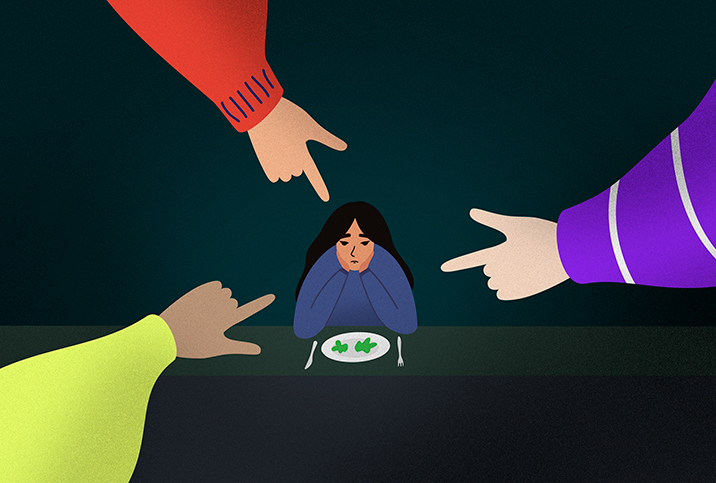If Food Strikes Fear, Check for ARFID

We all have dishes that make us salivate and ones we find revolting. However, for people with avoidant restrictive food intake disorder (ARFID), a wide variety of foods can elicit feelings of anxiety, repulsion or fear, leaving a limited number of foods that feel safe to eat. Previously known as selective eating disorder, ARFID is characterized by extreme selective eating behaviors, which can substantially impact a person's development, health and relationships.
People with ARFID tend to consume a minimal number of foods or have little desire to eat at all. In this sense, as well as its association with nutritional deficiencies and negative associations with eating, ARFID is similar to anorexia nervosa. However, people with ARFID do not have distorted body image or an obsession or anxiety about weight.
Listed in the Diagnostic and Statistical Manual of Mental Disorders, Fifth Edition (DSM-5) in 2013, ARFID is one of the most recently recognized and lesser-known eating disorders. It's also one of the least understood, particularly among teens and adults.
ARFID and picky eating
Most people with ARFID have been selective or "picky" eaters since early childhood, according to Martin M. Fisher, M.D., a New York-based physician specializing in pediatric medicine and eating disorders. However, most selective eaters don't end up with ARFID.
"Selective eating is a whole different area than ARFID," Fisher said.
"Food neophobia, or being unwilling to try new foods, is a normal part of child development and tends to reduce by 6 years old," said Rachel Evans, Ph.D., a chartered psychologist and eating disorder recovery therapist based in Derby in the United Kingdom. "Being a picky eater can be inconvenient, for example, when eating at a restaurant. Still, most people get by and can meet their daily energy requirements. On the other hand, those with ARFID have significant impairments in daily functioning and are often unable to gain sufficient nutrition from the limited number of foods that they're willing to eat."
Evans noted some people with ARFID show no interest in food or eating, or report not feeling hungry, characteristics less common in picky eaters.
Causes and risk factors
Biological, psychological, social and environmental factors can make a person more likely to develop ARFID, according to the National Eating Disorders Association. Although more research is needed, evidence indicates people with autism spectrum conditions, attention-deficit/hyperactivity disorder (ADHD) and intellectual disabilities are at higher risk.
Evans and Fisher said that besides lacking interest in food, a person may develop ARFID due to sensory sensitivities, including intolerance for the taste, texture, smell or appearance of certain foods. This is often the case for individuals with autism and ARFID, said Kim Anderson, Ph.D., a licensed clinical psychologist and the executive director of the Eating Recovery Center in Baltimore.
"The sensory sensitivities associated with ARFID and autism may be an underlying factor that helps explain the link between these two illnesses," she explained. "For individuals with autism, general sensory experiences such as smells, noises, textures and body sensations are often perceived as intense, harmful and distressing. This alteration in sensory processing may make mealtime very challenging given that the act of eating involves multiple senses, including vision, touch, taste and smell. In this regard, a limited diet and ritualistic eating behaviors may be considered an extension of the repetitive and restrictive behaviors that are distinctive features of autism."
Fisher, Anderson and Evans all noted people might develop an aversion to foods after a negative experience, such as choking, an allergic reaction, stomach pain or vomiting. However, according to Fisher, only about 10 percent to 15 percent of patients fall into this group.
In some cases, ARFID stems from a psychologically traumatic event, Evans said.
"Trauma from triggering events, [such as] abuse, car accident, death of a loved one, can lead to the development of ARFID as a coping mechanism to help someone to avoid or suppress negative emotions," Evans said.
In other cases, co-occurring anxiety disorders may cause or exacerbate restrictive eating behaviors.
"Anxiety has been identified as a possible maintaining mechanism for the food avoidance seen in ARFID," Anderson explained. "In some cases, the fear of new foods and selective eating can be conceptualized as anxiety that has been conditioned by a fear of negative outcomes associated with eating. For example, when someone experiences an upsetting eating event, such as illness or choking, they may learn to fear the food, the situation and the sensations associated with the event. This may lead to avoiding certain foods or eating only 'safe' foods in 'safe' settings. Accordingly, some patients with ARFID develop social anxiety due to the avoidance of social situations involving food."
Mental and physical health effects
Like many mental health conditions, ARFID is typically diagnosed when it's clear a person's life and well-being are significantly impacted, and when another medical diagnosis cannot better explain the symptoms.
Fisher and his team saw about 300 eating disorder patients per year pre-pandemic, a number that's doubled since spring 2020. Many of these patients have ARFID and seek treatment because of the effect of their behavior on their health or family.
"One of the things that can happen if you are a picky eater, you might grow fine until maybe you get to 8, 9, 10, 11 or 12, when you expect to start heading toward a growth spurt," Fisher said. "You may not be eating enough for the growth spurt to occur as it should. At that point, it becomes a concern for families and pediatricians."
Evans said this inability to meet physical developmental milestones can affect long-term growth, as well, adding that patients with ARFID who do not eat enough food or a sufficient variety are at risk of developing nutrient deficiencies, gastrointestinal issues and cognitive symptoms.
"Restrictive eating can result in a variety of emotional, behavioral and cognitive problems, such as low mood, irritability, anxiety, reduced concentration, cognitive inflexibility and social isolation," Anderson explained. "Fortunately, these changes tend to improve as individuals move through recovery and become fully nourished. Even in the early stages of treatment—where the focus is on increasing the volume and variety of food—we often see immediate improvements in patients' mood and thinking as they begin to eat regularly. This allows them to participate more actively in the cognitive and behavioral therapy strategies that will help guide them through the recovery process."
ARFID can lead to interpersonal challenges, anxiety and fear related to eating in social settings.
"For example, children may be unable to eat anything on offer at birthday parties or a sleepover without preplanning, and adults may worry days in advance about eating out at a restaurant," Evans said.
"They often express concerns about being embarrassed, unable to eat what is offered and faced with uncomfortable questions about their eating," Anderson added. "As a result, social eating situations are often avoided. This can lead to feelings of isolation, loneliness and may even interfere with social development."
Getting treated
As with most eating disorders, treatment for ARFID is individualized and multidisciplinary, typically involving a combination of medical, nutritional and psychological care.
All patients undergo a thorough medical evaluation, and some receive immediate interventions, such as hospitalization or food supplementation, to mitigate the effects of malnutrition. Fisher noted most patients are evaluated to determine if any physical complications, such as difficulty chewing or swallowing, have caused their restrictive eating. If so, they may see a speech and language therapist as part of their treatment plan.
"Once stable, patients will engage in psychotherapy using evidence-based cognitive and behavioral strategies to increase the variety and volume of foods, gain weight as needed and address associated anxiety or other difficulties," Anderson said. "For children and adolescents, a family-based behavioral approach to ARFID may be preferred. In addition to medical monitoring and psychotherapy, patients may also benefit from medication for anxiety, nutritional counseling and occupational therapy."
According to Fisher, most patients make a full recovery.


















